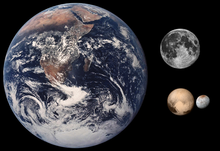Double planetary system
Double planet system (also short double planet ) is in astronomy an informal term for the system of a planet with a large satellite , which has a relatively similar size compared to the regular proportions in the solar system .
In the literal sense, a double planet would be a system of two planets which, due to their spatial proximity, are gravitationally bound to each other and, according to Kepler's laws, move in orbits around a common center of gravity . In the theoretical ideal case of two celestial bodies of exactly the same mass , the common center of gravity lies exactly in the geometric center of the system and the distance between the two body centers is twice the average orbit radius .
Concept history
Earth moon
The term originally came up for the system of the earth and its unusually large moon . Their size ratio is 1: 3.7 and the mass ratio is 1:81; this has raised the classic question of the origin of the moon . According to the most conservative view according to the cosmogony of Immanuel Kant from 1755, the earth and moon emerged from a common local compression within the presolar primeval cloud and formed a double agglomeration from the outset. This hypothesis is therefore sometimes referred to in the literature as the double planet hypothesis compared to the other views . The modern computer-aided so-called collision theory describes the formation of the moon through the collision of a planet roughly the size of Mars with the earth. The use of the term double planet occurs over time, regardless of the cause.
Venus - Mercury
With regard to the very earth- moon- like hemispheres of Mercury and its very eccentric orbital ellipse, there is a hypothesis that it is an escaped moon of Venus .
Pluto - Charon
Since the discovery of the relatively large Pluto moon, the Pluto - Charon system has also been sometimes referred to as a double planet. The ratio of the diameter is around 1: 2 and that of the masses around 1: 6.6. This leads to the fact that the center of gravity ( barycenter ) of the Pluto-Charon system is 1200 km above Pluto's surface. Strictly speaking, Pluto and Charon orbit each other, so these two celestial bodies correspond to the idea of a double planet much more closely than Earth and Moon. A major collision is also increasingly favored for the creation of Charon .
In August 2006, as part of the debate about the first scientific definition of a planet , the International Astronomical Union discussed whether Pluto and Charon should jointly receive the status of planets of the Pluton class as a double planet . In the discussed concept of a planet, it was suggested as a criterion for the existence of a double system that the common center of gravity of the two planets must lie outside the larger one.
Ultimately, the IAU decided against this draft. With the adopted planet definition, Pluto was revoked its planetary status and classified in the newly created class of dwarf planets ; Charon was not affected as a companion by this redefinition, so that he is still officially considered the moon and, by definition, does not form a double dwarf planet system with Pluto.
Exoplanets
In the case of planets of other stars, the so-called exoplanets , exomonde are difficult to detect due to the difficult observation methods .
In 2017 the discovery of the first double planet 2MASS J1119–1137 with two brown dwarfs of roughly the same weight and about four times the mass of Jupiter , which were observed at the Keck Observatory on Hawai'i , was announced. The two celestial bodies are not tied to a star , orbit each other at a distance of about four astronomical units with an orbital period of several decades and are assigned to the TW-Hydrae Association , which is a region of young stars about 160 light years apart is about our solar system.
See also
Individual evidence
- ↑ New definition - number of planets is to increase (quote: "Charon, who was previously considered Pluto's moon, forms a double planetary system together with Pluto.")
- ↑ Rainer Kayser: Two planets without a star discovered , Welt der Physik from July 11, 2017, accessed on July 12, 2017
- ↑ William MJ Best1, Michael C. Liu, Trent J. Dupuy, Eugene A. Magnier: The Young L Dwarf 2MASS J11193254-1137466 Is a Planetary-mass binary , The Astrophysical Journal Letters, Volume 843, Number 1, The American Astronomical Society , June 23, 2017, accessed July 12, 2017
